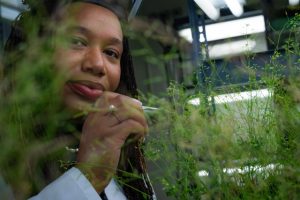DurreShahwar (Durre) Muhammad: Plant Physiology First Author

 DurreShahwar (Durre) Muhammad, first author of “POPEYE intercellular localization mediates cell-specific iron deficiency responses”
DurreShahwar (Durre) Muhammad, first author of “POPEYE intercellular localization mediates cell-specific iron deficiency responses”
Current Position: NSF Postdoctoral Fellow in Biology, Rice University, Houston, TX USA
Education: Ph.D. from North Carolina State University in the Department of Plant & Microbial Biology, B.S from University of Illinois at Chicago in Biological Sciences
Non-scientific Interests: Outdoor activities with my husband and children, cooking and entertaining family and friends, traveling
Brief bio: I grew up less than two miles from the Museum of Science and Industry and less than 10 miles from the Field Museum, Shedd Aquarium, and the Adler Planetarium in Chicago, Illinois. I often visited these museums, and by high school, I volunteered at the Museum of Science and Industry, solidifying my love of science and engaging with visitors about exhibits. I obtained my bachelor’s degree in Biological Sciences at the University of Illinois at Chicago. I worked as a research specialist in the Molecular, Cell & Developmental Biology department after graduating. During this period, Dr. Katherine Warpeha and Dr. Terri Long introduced me to plant stress research (UV damage and iron deficiency). I started my Ph.D. work at North Carolina State University in the Department of Plant & Microbial Biology to study the role of POPEYE as a transcriptional regulator of iron homeostasis. Although my work focused on iron homeostasis, POPEYEs’ direct interaction with a peroxisomal gene (PEX11b) interested me in this undervalued organelle. Following the completion of my Ph.D., I started my postdoctoral fellowship at Rice University (Houston, TX) in the BioSciences Department, working with Dr. Bonnie Bartel to elucidate the mechanisms that maintain cellular health through accurate organelle degradation. I just received NIH MOSAIC (K99/R00) funding to work on uncovering signals and pathways that govern peroxisome dynamics and communication with other organelles in Arabidopsis thaliana with the hopes that discoveries can be translated over to crop plants and human health.


